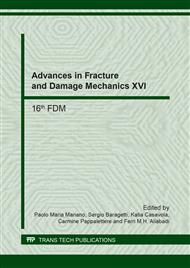p.279
p.283
p.287
p.291
p.295
p.299
p.303
p.309
p.313
Measuring Deformations in a Rigid-Hulled Inflatable Boat
Abstract:
Rigid-hulled inflatable boats are extremely practical and popular nowadays. They offer a valid compromise between flexibility, handiness, performance and, finally, costs, supporting the pleasure of sailing. Their large use entails the fact that these crafts can be subjected to very different sailing conditions. The design has to be stable and seaworthy, mainly assured by hydroplaning hulls and unsinkable inflated tubes. When they are designed with extremely performing hydroplaning hulls, since their low weight, these crafts are able to outperform several types of similarly sized and powered boats. In the current study, experimental mechanics techniques were used to measure the strains showed by a rigid-hulled inflatable boat during sailing. Measure were used as a base for further considerations toward the design optimization of the hull in fiberglass.
Info:
Periodical:
Pages:
295-298
Citation:
Online since:
September 2017
Authors:
Keywords:
Price:
Сopyright:
© 2017 Trans Tech Publications Ltd. All Rights Reserved
Share:
Citation:


